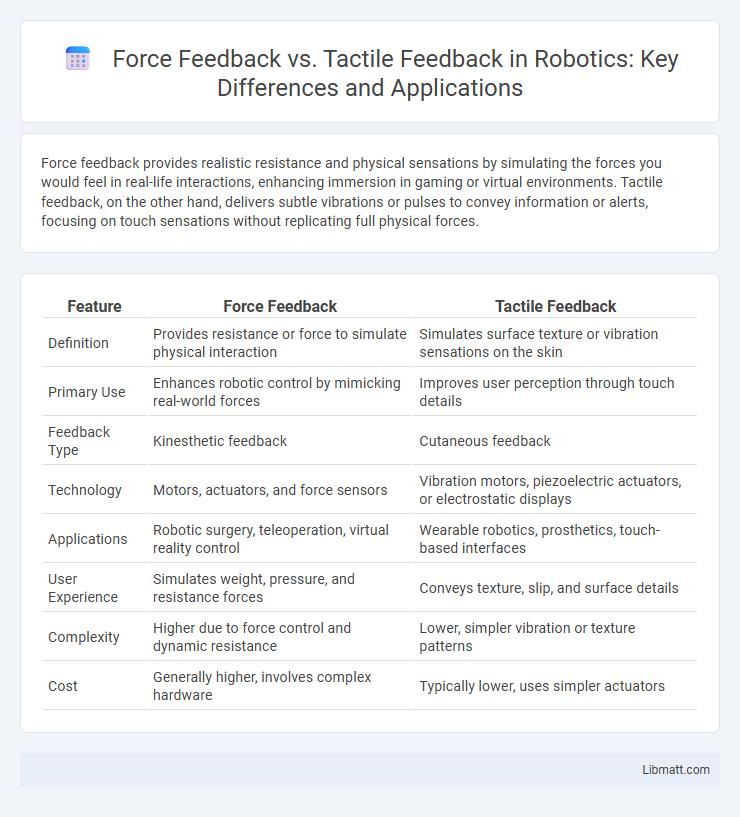Force feedback provides realistic resistance and physical sensations by simulating the forces you would feel in real-life interactions, enhancing immersion in gaming or virtual environments. Tactile feedback, on the other hand, delivers subtle vibrations or pulses to convey information or alerts, focusing on touch sensations without replicating full physical forces.
Table of Comparison
| Feature | Force Feedback | Tactile Feedback |
|---|---|---|
| Definition | Provides resistance or force to simulate physical interaction | Simulates surface texture or vibration sensations on the skin |
| Primary Use | Enhances robotic control by mimicking real-world forces | Improves user perception through touch details |
| Feedback Type | Kinesthetic feedback | Cutaneous feedback |
| Technology | Motors, actuators, and force sensors | Vibration motors, piezoelectric actuators, or electrostatic displays |
| Applications | Robotic surgery, teleoperation, virtual reality control | Wearable robotics, prosthetics, touch-based interfaces |
| User Experience | Simulates weight, pressure, and resistance forces | Conveys texture, slip, and surface details |
| Complexity | Higher due to force control and dynamic resistance | Lower, simpler vibration or texture patterns |
| Cost | Generally higher, involves complex hardware | Typically lower, uses simpler actuators |
Understanding Force Feedback: Definition and Mechanisms
Force feedback is a haptic technology that simulates physical resistance by applying varying levels of force to a user's input device, enhancing immersion in virtual environments. It operates through actuators and motors that dynamically generate opposing forces to replicate real-world sensations like friction, weight, or impact. This mechanism contrasts with tactile feedback, which primarily provides localized vibrations or stimuli without simulating physical resistance.
What is Tactile Feedback? Key Concepts Explained
Tactile feedback refers to the sensation experienced through the skin when interacting with devices, providing precise, localized vibrations or pressure to simulate texture and touch. It differs from force feedback, which replicates resistance and physical forces for a more immersive experience, often used in gaming and simulations. Your understanding of tactile feedback enhances device interaction by delivering subtle cues that improve usability and realism.
Core Differences Between Force Feedback and Tactile Feedback
Force feedback simulates physical resistance and motion by applying actual forces to your muscles through devices like steering wheels or joysticks, creating a realistic interaction with virtual environments. Tactile feedback, also known as haptic feedback, focuses on stimulating the skin with vibrations or pulses to convey texture, alerts, or subtle sensations without exerting real forces. Understanding these core differences helps you choose the right technology to enhance immersion or communication depending on whether physical interaction or sensory detail is prioritized.
Applications of Force Feedback in Modern Technology
Force feedback is widely applied in modern technology for immersive virtual reality experiences, advanced gaming controllers, and precise robotic surgery tools, providing users with realistic physical sensations that enhance interaction accuracy. Your training simulators for aviation and automotive industries utilize force feedback to replicate real-world resistance and improve skill acquisition under safe conditions. These applications make force feedback essential for improving control, safety, and realism in various high-tech environments.
Tactile Feedback Uses in Consumer Devices
Tactile feedback in consumer devices enhances user interaction by simulating touch sensations through vibrations and pressure changes, commonly found in smartphones, gaming controllers, and wearable technology. This haptic technology improves user experience by providing intuitive responses to touchscreen inputs, notifications, and virtual environments. Advances in tactile feedback systems enable more precise and immersive control, contributing to accessibility and increased engagement across diverse applications.
User Experience: Comparing Force and Tactile Feedback
Force feedback delivers a more immersive user experience by simulating real-world resistance and dynamic forces, enhancing precision in gaming and simulation. Tactile feedback provides subtle vibrations or pulses that improve touch interaction and alertness without replicating physical force. Your experience will vary based on application, with force feedback offering deeper realism and tactile feedback boosting intuitive touch responsiveness.
Force Feedback vs Tactile Feedback in Gaming
Force feedback in gaming delivers resistance and physical sensations through controllers or steering wheels, enhancing realism by simulating forces like collisions or terrain texture. Tactile feedback provides localized vibrations or pulses to mimic events such as gunfire or footsteps, enriching immersion through subtle touch cues. Combining both feedback types improves gameplay experience by offering comprehensive sensory input that aligns with in-game actions and environments.
Industrial and Medical Applications: A Comparative Analysis
Force feedback provides precise resistance and motion simulation essential for industrial robotics and medical simulators, enhancing operator control and training accuracy. Tactile feedback delivers localized touch sensations critical for delicate medical procedures and quality inspections in manufacturing, improving user detection of texture and surface irregularities. Combining force and tactile feedback technologies optimizes haptic interaction in complex environments, increasing safety and performance in both industrial automation and healthcare interventions.
Advantages and Limitations: Force vs Tactile Feedback
Force feedback provides a more immersive and realistic experience by simulating physical forces, enhancing your interaction with virtual environments and improving precision in applications like gaming and training simulators. However, it often requires more complex hardware and higher power consumption, making it less suitable for portable or low-cost devices. Tactile feedback, while limited to surface-level sensations like vibrations and taps, offers simpler, energy-efficient implementation ideal for mobile devices but lacks the depth of physical realism found in force feedback systems.
Future Trends in Haptic Feedback Technology
Force feedback technology is advancing towards more precise and dynamic resistance simulation, enabling immersive virtual reality and robotics applications. Tactile feedback is evolving with high-resolution actuators that mimic textures and fine vibrations, enhancing user interaction in wearable devices and mobile interfaces. Emerging trends include integrating AI-driven haptics for adaptive and personalized feedback, significantly improving realism and user engagement in gaming, medical training, and remote control systems.
Force Feedback vs Tactile Feedback Infographic

 libmatt.com
libmatt.com